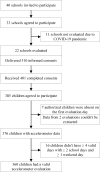Accelerometry-assessed daily physical activity and compliance with recommendations in Spanish children: importance of physical education classes and vigorous intensity
- PMID: 38468640
- PMCID: PMC10926909
- DOI: 10.7717/peerj.16990
Accelerometry-assessed daily physical activity and compliance with recommendations in Spanish children: importance of physical education classes and vigorous intensity
Abstract
Background: Physical activity (PA) is associated with numerous health benefits. Vigorous PA (VPA) may have a greater impact on public health than lower-intensity PA. The incorporation of a specific recommendation on VPA could complement and improve existing recommendations for average daily moderate-vigorous PA (MVPA). Physical education classes could have a positive impact on children's adherence to average daily physical activity recommendations. The aim was to investigate the association between MVPA and VPA in children, as well as adherence to recommendations, and obesity and the presence of physical education classes.
Methods: A cross-sectional study of physical activity was conducted in a sample of 8 and 9-year-old children in Andalusia (Spain). GENEActiv accelerometers were used, placed on the non-dominant wrist for at least eight consecutive days (24-h protocol). School days with and without physical education class, and weekend days were defined. ROC curves were used to calculate the threshold associated with obesity for average daily MVPA and VPA for recommendations.
Results: A total of 360 schoolchildren were included in the analyses (184 girls). An average of 7.7 (SD 1.4) valid days per participant were evaluated, with 19.9 (SD 10.5) and 11.4 (SD 5.1) minutes of VPA performed by boys and girls respectively. 25.8% of the participants were classified with central obesity. The optimal threshold determined with ROC analysis was 12.5 and 9.5 minutes of average daily VPA for boys and girls, respectively (RecVPA), and 75 minutes of average daily MVPA for both sexes (RecMVPA). The RecVPA showed stronger association with obesity. On school days with physical education class, compared to days without this class, children showed increased VPA and MVPA engagement and better compliance with recommendations, with smaller differences in adherence according to sex or obesity.
Conclusions: On days with physical education class, more physical activity was accumulated at all intensities and greater adherence to the recommendations than on days without this class. VPA had a stronger correlation with the absence of obesity than lower-intensity activity. It was also observed that boys were physically more active and had higher adherence to the recommendations than girls.
Keywords: Children; Guidelines; Moderate-to-vigorous physical activity; Obesity; Overweight; Physical activity; Physical education classes; Recommendations; Sex differences; Vigorous physical activity.
© 2024 Benavente-Marín et al.
Conflict of interest statement
Julia Wärnberg and Napoleón Pérez-Farinós are Academic Editors for PeerJ.
Figures


Similar articles
-
Adherence to the WHO recommendation of three weekly days of vigorous intensity activities in children: an accelerometry study of vigorous physical activity bouts.PeerJ. 2024 Feb 21;12:e16815. doi: 10.7717/peerj.16815. eCollection 2024. PeerJ. 2024. PMID: 38406285 Free PMC article.
-
Recommended levels of physical activity to avoid adiposity in Spanish children.Pediatr Obes. 2013 Feb;8(1):62-9. doi: 10.1111/j.2047-6310.2012.00086.x. Epub 2012 Sep 7. Pediatr Obes. 2013. PMID: 22961693
-
Descriptive analysis of preschool physical activity and sedentary behaviors - a cross sectional study of 3-year-olds nested in the SKOT cohort.BMC Public Health. 2017 Jun 30;17(1):613. doi: 10.1186/s12889-017-4521-3. BMC Public Health. 2017. PMID: 28666428 Free PMC article.
-
Frequency of Vigorous physical activity and sleep difficulty in adolescents: A multiply-country cross-sectional study.Complement Ther Clin Pract. 2024 May;55:101843. doi: 10.1016/j.ctcp.2024.101843. Epub 2024 Mar 4. Complement Ther Clin Pract. 2024. PMID: 38507878 Review.
-
Evidence-Based Overview of Accelerometer-Measured Physical Activity during School Recess: An Updated Systematic Review.Int J Environ Res Public Health. 2021 Jan 12;18(2):578. doi: 10.3390/ijerph18020578. Int J Environ Res Public Health. 2021. PMID: 33445554 Free PMC article.
Cited by
-
Can the Components of Physical Fitness Be Linked to Creative Thinking and Fluid Intelligence in Spanish Schoolchildren?Healthcare (Basel). 2025 Jul 12;13(14):1682. doi: 10.3390/healthcare13141682. Healthcare (Basel). 2025. PMID: 40724707 Free PMC article.
-
Adherence to the WHO recommendation of three weekly days of vigorous intensity activities in children: an accelerometry study of vigorous physical activity bouts.PeerJ. 2024 Feb 21;12:e16815. doi: 10.7717/peerj.16815. eCollection 2024. PeerJ. 2024. PMID: 38406285 Free PMC article.
-
Understanding Health in Spanish Children: The Role of Demographics in Physical Activity and Nutrition Attitudes.Children (Basel). 2025 Jun 20;12(7):811. doi: 10.3390/children12070811. Children (Basel). 2025. PMID: 40723004 Free PMC article.
References
-
- Ávila-García M, Esojo-Rivas M, Villa-González E, Tercedor P, Huertas-Delgado FJ. Relationship between sedentary time, physical activity, and health-related quality of life in Spanish children. International Journal of Environmental Research and Public Health. 2021;18(5):2702. doi: 10.3390/ijerph18052702. - DOI - PMC - PubMed
-
- ALADINO . ALADINO 2019: Surveillance study on nutrition, physical activity, child development and obesity in Spain 2019. Madrid: Agencia Española de Seguridad Alimentaria y Nutrición, Ministerio de Consumo; 2020.
-
- Antczak D, Lonsdale C, Del Pozo Cruz B, Parker P, Sanders T. Reliability of GENEActiv accelerometers to estimate sleep, physical activity, and sedentary time in children. The International Journal of Behavioral Nutrition and Physical Activity. 2021;18(1):73. doi: 10.1186/s12966-021-01143-6. - DOI - PMC - PubMed
MeSH terms
LinkOut - more resources
Full Text Sources

